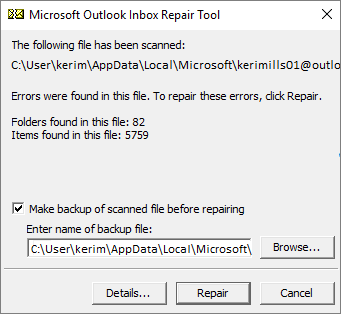Repair Outlook Data Files (.PST)
Applies To: Outlook 2016 Outlook 2013 Outlook 2010 Outlook 2007
If your Microsoft Outlook Data File (.pst and .ost) won’t open, or if you suspect the file is damaged, use the Inbox Repair tool (SCANPST.EXE) to diagnose and repair errors in the data file. The Inbox Repair tool checks the Outlook data files on your computer to see if they’re in good shape.
If you’re using a Microsoft Exchange account and your offline Outlook Data File (.ost) is missing items, you can safely delete the file. Outlook will recreate the file the next time the program opens.
Note: The Inbox Repair tool doesn’t connect or analyze any data stored in an Exchange mailbox. The tool only looks for errors (corruption), and there are any, gives you the opportunity to allow the tool to fix those errors
Repair a .pst file
- Exit Outlook and do one of the following:
- Browse to C:\Program Files.
or
- Browse to C:\Program Files (x86).
- Browse to C:\Program Files.
- In the Search box, type SCANPST.EXE.
Notes: If the search doesn’t find SCANPST.EXE in one folder, try searching in the other folder mentioned in step 1. Navigate to the folder location based on your version of Outlook.
- Outlook 2016: C:\Program Files (x86)\Microsoft Office\root\Office16
- Outlook 2013: C:\Program Files (x86)\Microsoft Office\Office15
- Outlook 2010: C:\Program Files (x86)\Microsoft Office\Office14
- Outlook 2007: C:\Program Files (x86)\Microsoft Office\Office12
- Open SCANPST.EXE.
- In the Enter the name of the file you want to scan box, enter the name of the .pst file you want the tool to check, or choose Browse to select the file.
Note: By default, a new log file is created during the scan. You can choose Options and opt not to have a log created, or you can have the results appended to an existing log file.
- Choose Start to begin the scan.
- If the scan finds errors, choose Repair to start the process to fix them.
Note: The scan creates a backup file during the repair process. To change the default name or location of this backup file, in the Enter name of backup file box, enter a new name, or choose Browse to select the file you want to use.
- When the repair is complete, start Outlook with the profile associated with the Outlook Data File you just repaired.
Other Outlook folders
In the Folder Pane, you might see a folder named Recovered Personal Folders that contains your default Outlook folders or a Lost and Found folder. Although the repair process might recreate some of the folders, they may be empty. The Lost and Found folder contains any folders and items recovered by the repair tool that Outlook can’t place in their original structure.
Create new data file
You can create a new Outlook Data File and drag the items in the Lost and Found folder into the new data file. After you’ve moved all the items, you can remove the Recovered Personal Folders (.pst) file, including the Lost and Found folder.
Recover items from the backup (.bak) file
If you can open the original Outlook Data File, you might be able to recover additional items. The Inbox Repair tool creates a backup file with the same name as the original, but with a .bak extension, and saves it in the same folder. There may be items in the backup file that you might be able to recover that the Inbox Repair tool couldn’t.
- Browse to the folder where the .pst file is stored and you’ll find the .bak file (for example, kerimills01@outlook.com.bak) created by the Inbox Repair tool.
- Make a copy of the .bak file and rename it with a bak.pst extension. For example, kerimills01@outlook.com.bak.pst.
- Import the bak.pst file into Outlook, and use the Import and Export Wizard to import any additional recovered items into the newly created .pst file.

